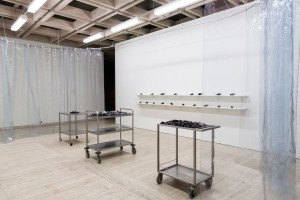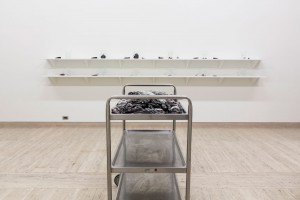Weak in Colour but Strong in Blood: Canberra Contemporary Art Space

Weak in Colour but Strong in Blood, 2013 - 2014
Found objects and hand blown glass
Variable

Weak in Colour but Strong in Blood, 2013 - 2014
Found objects and hand blown glass
Variable
Yhonnie Scarce
4 Dec 2015 - 13 Feb 2016
Yhonnie Scarce’s work is political in nature, but can only arrive at this point through the personal. Her heritage is from both the Nukunu people, whose land stretches from Port Pirie to Port Lincoln along the coastal region of South Australia, and the Kokatha Mula people, whose land extends from the Mallee to the Eyre Peninsula homelands. Scarce’s practice is concerned with the affect of colonial history on Indigenous Peoples living in current-day Australia.
First shown at the 19th Biennale of Sydney, Scarce’s Weak in Colour but Strong in Blood is a powerful installation. On first encounter, the audience sees some kind of medical set-up, blurred through plastic curtains that throw their rippled shadows on to the floor. Walking into the space, the medical instruments, trolleys and shelves become clearer, all stark and clinical. The trolleys are full of vessels modelled from fruit skins such as bush plums, bush bananas and yams, made in glass ranging from very transparent to very dark. The glass is ordered due to its colour – some trolleys show smooth gradients of tone while others have a stark black and white contrast. Some of the glass is intact, others pieces are shattered. The shelves on the back wall of the room are lined with beakers, tubes, scissor clamps, all stretching and contorting the elegant glass forms. These little experiments also seem invested in particular focus on the hue of the vessels. The divergent and natural forms of the fruit skins stand out as greatly different to that of the crisply crafted beakers. Glass is a strong medium, but the way the medical instruments disfigure it is unsettling – more than just shattering it, it alters its material nature. Many vessels shatter and looking at the trolleys, one can’t help but wonder if these were the pieces that didn’t with stand the experiments. The plastic curtains capture sound and blur the outside of the room, making this space feel as though it exists in a memory or a dream, while the sleek mass-produced medical objects make the room feel cold and threatening. Scarce’s work often references the museum space by showing works in the manner of museological displays but here moves on from that by expanding into a navigable space which references real historical place. The clear curtains making it feel like a memory passed down to Scarce through generations, blurry on the edges but nonetheless there.
From her statement on the work, Scarce’s installation “references the medico-scientific eugenic practices of the early 1900s, particularly those performed by the Australian anthropologist and ethnologist Norman Tindale, including Scarce’s own family members.” While clearly working from and commenting on this history, Scarce assumes intelligence on the part of the viewer and lets them reach this point without hammering it in – the unsettling and bleak atmosphere speaks loudly but not blatantly. Scarce’s Weak in Colour but Strong in Blood places the audience in a dark history that still endures today, leaving impressions by such research tragically misrepresenting Aboriginal peoples. The story may be one that directly relates to Scarce herself, but is undeniably the story of many Indigenous Australian Peoples.
– Angus McGrath, 2015
